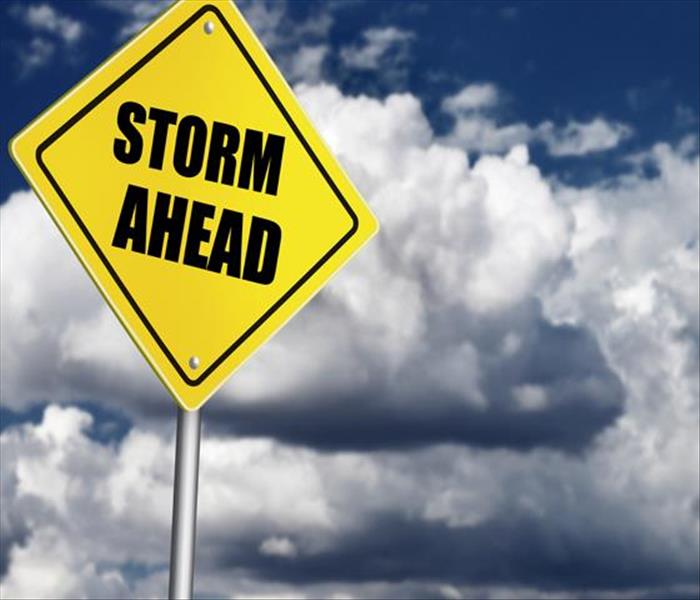Information on Hurricanes and Other Tropical Storm Systems for Dallas
5/22/2015 (Permalink)
Information on Hurricanes and Dallas Storm Systems
We hear every day about devastating storm systems, including Dallas hurricanes and tropical storms. If you have ever wondered how hurricanes get their names or what makes a hurricane and a tropical storm different, you are not alone.
Hurricanes, Tropical Storms, and Other Terminology
A tropical cyclone causes tropical depressions, tropical storms, and hurricanes. These low pressure systems form in the tropics and cause extreme weather such as strong winds and thunderstorms. There are three types of storm formed by a tropical cyclone.
A tropical depression is the mildest, with defined surface circulation but no spiral shape or eye. It has maximum wind speeds of 38 MPH or less.
A Dallas tropical storm has a spiral shape but no eye. It is stronger than a tropical depression but milder than a hurricane, with maximum sustained winds of 39-73 MPH.
A hurricane is the most intense tropical weather system, with the distinctive spiral shape and an eye in the center. Hurricanes, or typhoons, include thunderstorms and 74 MPH or higher maximum sustained winds that can devastate entire regions.
Both tropical storms and hurricanes can cause a storm surge, a large amount of water flooding the coastline. This wall of water is up to 25 feet tall and 50-1000 miles wide. A storm surge is pushed onto land by high winds. When combined with normal high tide, a storm surge is called a storm tide.
Storm Season
Hurricane season in the United States covers the warmer months, from June to November, although the peak season is August through October. The Atlantic Coast and the coast of the Gulf of Mexico are most affected, although the Southwest and the Pacific Coast may experience tropical storms and hurricanes that begin off the coast of Mexico. The effects of storm systems can be immense both on coastlines and inland. Winds may exceed 155 MPH; tornadoes, storm surges, and microbursts are common.
The Saffir-Simpson Scale
Hurricanes are classified as one of five categories by the Saffir-Simpson Scale. Category is determined by damage potential, central pressure, and maximum sustained wind speed. While Categories One and Two hurricanes are serious, Category Three and higher are devastating.
A Category 1 hurricane has mild damage to vegetation and unanchored structures, with storm surges of 4-5 feet and winds of 74-95 MPH.
A Category 2 hurricane causes moderate damage including flooding, roof damage, and destruction of light structures. Storm surges are 6-8 feet, and winds reach 96-110 MPH.
A Category 3 hurricane includes extensive damage including damage to small structures and cutting off roads in low areas. Storm surges reach 9-12 feet and winds are sustained at 111-130 MPH.
A Category 4 hurricane has extreme damage, including flooding and damage to homes. Trees may be blown over and roads cut off. Storm surges reach 13-18 feet, and winds reach 131-155 MPH.
A Category 5 hurricane destroys buildings and vegetation. Storm surges top 18 feet, cutting off roads and flooding large areas, while winds exceed 155 MPH.
Naming Storms
Six separate and alternating lists of names for Atlantic tropical storms were created by the National Hurricane Center in 1953. Only female names were used until 1979; since then, men's and women's names alternate. When a storm leaves incredible damage, such as Katrina in 2005, the name is retired from the list and replaced.
Preparedness steps and more information on hurricanes can be found in the FEMA-247 publication "Against the Wind: Protecting Your Home from Hurricane and Wind Damage."
What To Do After Flooding
- Remove excess water by mopping and blotting.
- Wipe excess water from wood furniture after removal of lamps and tabletop items.
- Remove and prop wet upholstery and cushions.
- Place aluminum foil or wood blocks between furniture legs and wet carpeting.
- Turn air conditioning on for maximum drying in summer.
- Remove colored rugs from wet carpeting.
- Remove art objects to a safe, dry place.
- Gather loose items from floors.
What NOT To Do After Flooding
- Don't leave wet fabrics in place. Hang furs and leather goods.
- Don't leave books, magazines or other colored items on wet carpet or floors.
- Don't use your household vacuum to remove water.
- Don't use television or other household appliances.
- Don't turn on ceiling fixtures if ceiling is wet, and keep out of rooms where ceilings are sagging.
Water damage can strike your Dallas commercial property at any time. Water damage can sideline your business. Every hour spent cleaning up is an hour of lost revenue and productivity. So when you have an emergency water event, SERVPRO of Northwest Dallas offers fast, 24 hour emergency services, 365 days per year. Help is waiting at (214) 361-7887.





 24/7 Emergency Service
24/7 Emergency Service